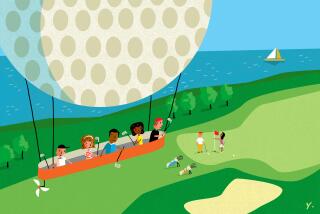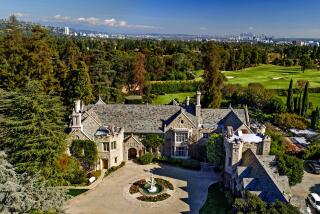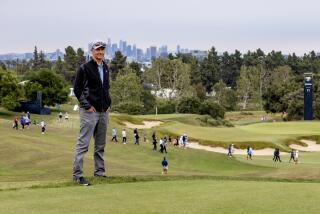Author Enjoyed a Real Bond With This British Open Site
- Share via
Royal St. George’s, site of this week’s 132nd British Open, has certainly seen its share of golfing history, with a list of champions that includes J.H. Taylor, Harry Vardon, Walter Travis, Walter Hagen, Bobby Locke and Greg Norman. Yet despite this pedigree, it can be reasonably argued that the most famous golf match ever to be played there was not an Open Championship, a British Amateur or even some lesser competitive event.
Indeed, it was a match that never really took place.
It is probably the highest-profile golf game in popular literature, the $10,000 contest between superspy James Bond and the eponymous villain of Ian Fleming’s classic novel “Goldfinger.”
Published in 1959, the seventh of Fleming’s Bond thrillers includes a plot to rob Ft. Knox and the famous bowler-hatted henchman Oddjob.
But for golfers, it is remembered as that rare occasion where the Royal and Ancient game is presented, with seriousness and importance, in a mainstream literary work.
Perhaps because he was a member of the club, Fleming, a stickler for realistic details, chose not to call his “fictional” course St. George’s; he instead used Royal St. Marks. But little attempt is made to mask the course’s true identity, from its location above Pegwell Bay, to the thatched-roof starter’s shack, the intimidating carry bunkers at the fourth hole or the celebrated one-shot sixth, the Maiden (which Fleming, with his usual edge of salaciousness, re-dubbed “the Virgin”).
Indeed, during the course of the match, the author substantially describes more than half of the holes and provides rough yardages for nearly all, with each matching St. George’s (circa 1959) perfectly.
The catch, modern readers may note, is that the golf course has been altered a bit over the years, with three or four holes no longer squaring with those of Goldfinger’s day.
Fleming was an avid golfer, playing to a nine handicap and holding memberships at St. George’s and Huntercombe. Not surprisingly, in James Bond, he created a rather aggressive player, a man given to attacking pins and shortcutting doglegs.
Goldfinger, on the other hand, plays a shorter, straighter, highly mechanical game. He also cheats at every opportunity, a state of affairs that requires Bond ultimately to resort to similarly underhanded measures.
Finding a Dunlop No. 7 ball at the 17th while helping search for Goldfinger’s poorly driven No. 1, Bond has his caddie discreetly switch the two after both men have holed out, the match all square. Bond then deliberately bogeys the 18th, appearing to lose, but when Goldfinger is “discovered” to have played the wrong ball, he automatically loses the hole and, consequently, his $10,000.
Curiously, it seems that the normally precise Fleming managed to misinterpret the rule book here, for the wrong ball would actually have been played on the 17th, making that the hole which Goldfinger should have lost.
Bond’s tanking of the last, then, should properly have resulted in the match being halved.
Despite the author’s closeness to St. George’s, Pinewood Studios’ proximity to Buckinghamshire’s Stoke Poges Golf Club led to the 1964 movie version of “Goldfinger” being filmed at that distinctly inland course. Soon thereafter, a seriously ill Fleming attended a meeting at St. George’s, where he was scheduled to become the club’s next Captain.
That evening, his already weakened heart finally succumbed and Fleming died at the Kent and Canterbury hospital the next morning, far from the limelight of James Bond but close to the layout that he fondly wrote was “the greatest seaside course in the world.”
More to Read
Go beyond the scoreboard
Get the latest on L.A.'s teams in the daily Sports Report newsletter.
You may occasionally receive promotional content from the Los Angeles Times.










